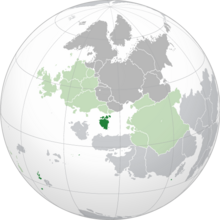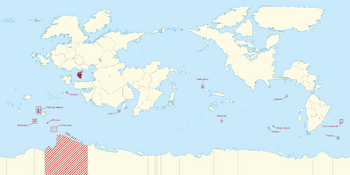Herastadt: Difference between revisions
mNo edit summary |
mNo edit summary |
||
| Line 52: | Line 52: | ||
|area_sq_mi = 64,961 | |area_sq_mi = 64,961 | ||
|percent_water = 5.1 | |percent_water = 5.1 | ||
|population_census = | |population_census = 34,736,912 | ||
|population_census_year = | |population_census_year = 2019 | ||
|population_density_km2 = 155.19 | |population_density_km2 = 155.19 | ||
|GDP_PPP = | |GDP_PPP = C·2.522 trillion | ||
|GDP_PPP_year = | |GDP_PPP_year = 2019 | ||
|GDP_PPP_per_capita = | |GDP_PPP_per_capita = C·72,602 | ||
|Gini = 34.3 | |||
|Gini_year = 2019 | |||
|HDI = 0.929 | |||
|Gini = | |HDI_year = 2019 | ||
|Gini_year = | |||
|HDI = 0. | |||
|HDI_year = | |||
|HDI_category = | |HDI_category = | ||
|currency = Commercia (C·) | |currency = Commercia (C·) | ||
Revision as of 06:11, 12 May 2020
This article is incomplete because it is pending further input from participants, or it is a work-in-progress by one author. Please comment on this article's talk page to share your input, comments and questions. Note: To contribute to this article, you may need to seek help from the author(s) of this page. |
Principality of Herastadt
| |
|---|---|
| Motto: "Libertas, Integritas, Patriae" "Liberty, Integrity, Country" | |
| Anthem: Raise the Crimson Standard | |
 Location of Herastadt and overseas holdings (dark green) – in Esermia (green & grey) | |

| |
| Capital | Piragon |
| Largest city | Petra |
| Official languages | Heran |
| Recognised regional languages | Various local dialects |
| Ethnic groups (2017) | 78.6% Heran 11.5% Darden 4.2% Zarov 5.7% Other |
| Religion (2017) | 57.8% Doxology 25.2% Irreligion 12.9% Pagan 4.1% Carnisian |
| Demonym(s) | Herastadtian |
| Government | Unitary parliamentary constitutional monarchy |
• Prince | Kristian II |
| Tasela Valteras | |
• Vice Chancellor | Jakob Kostavis |
| Legislature | Richtersmot |
| Formation | |
| 44CE | |
| 560 | |
| September 9, 1395 | |
| October 3, 1761 | |
• Regency | November 20, 1904 |
| June 9, 1909 | |
| January 1, 1926 | |
| Area | |
• Total | 140,910 km2 (54,410 sq mi) |
• Water (%) | 5.1 |
| Population | |
• 2019 census | 34,736,912 |
• Density | 155.19/km2 (401.9/sq mi) |
| GDP (PPP) | 2019 estimate |
• Total | C·2.522 trillion |
• Per capita | C·72,602 |
| Gini (2019) | 34.3 medium |
| HDI (2019) | 0.929 very high |
| Currency | Commercia (C·) (COM) |
| Time zone | Central Esermian Time (CET) |
| Date format | dd-mm-yyyy |
| Driving side | left |
| Calling code | +48 |
| Internet TLD | .hst |
Herastadt /hɛrɑːˈstɑːd/, officially the Principality of Herastadt; is an Esermian island state and constitutional monarchy situated in the Parazin Sea. Herastadt shares maritime borders to the north with the mainland nations of Bavmark and Ameiss, and to the south with Terados. Herastadt covers a total of 168,250 square kilometers, and has has an estimated population of 26 million; making it the 2nd-most densely populated nation in Esermia by landmass. Administratively, Herastadt comprises of twelve cantons and three autonomous federated governments.
Officially, Herastadt is headed by the reigning Prince or Princess of the House of Lindonis; which has ruled uninterrupted since the nation's foundation, with exception to the Regency period of 1904 to 1909. The current monarch, Kristian II, was inaugurated on 29 July 2015 after the abdication of his mother Anna I. The nation is legislatively governed by the bicameral legislature of the Richtersmot led by an elected Steward. Since 2017, Tasela Valteras of the Liberal Reform Party has served as the 21st consecutively democratically-elected Chancellor of Herastadt.
Etymology
Herastadt takes its name from the Classical Parathean Herasstadosa, translating into "(the) Land of Hera". This name is believed to have been a colloquial term for the island of Parathis, which later morphed into the inclusion of the greater Parathean Islands. Following the unification under Dardenic noble Kostav I, Early Princes held the official styling "Prince of the Isles" until Tasso I formalized the change to "Prince of Heraschtados" in 1512. As Middle Parathean gave way to the modern Heran language, the original form of Heraschtados morphed into modern Herastadas, reflecting the wider melding of the Dardenic culture of the ruling class with the culture and customs of the native Tarenian peoples.
More widely across Esermia and the world, the nation is known in its Dardenic translation as Herastadt; erroneously translating into "Hera's City". Numerous figures and political groups in the past have expressed desire to officially change the name of the nation as a result of this, however as of present no action has been taken.
History
Prehistory
The earliest evidence of settled human habitation in Herastadt reaches as far back as 7,000BCE; during the Mesolithic Age. At this time the isles are believed to have been part of a larger peninsula connected to the northern Esermian mainland. Much of this terrain is thought to have been flat grassland suitable for supporting the large roaming herds and hunter-gatherer tribes of the pre-agricultural eras. These peoples are believed to have been part of a wider group of people inhabiting Northern Esermia, identified as the Monolithids. Their population is believed to have been sparse, due to an inherent lack of long-term resource pooling and prevalence of any known lasting settlements. As their name indicates however, these people had a keen interest in erecting a great number of stone monoliths in the lands in which they inhabited. It was once commonly thought that these served as various monuments and effigies to the gods of these people, however contemporary theory tends toward the idea that these structures also served as 'anchoring points' for the quasi-nomadic people to settle their villages around.
With the onset of the Bronze Age around 3,000BCE came the migration of the Weaver people into Herastadt, crossing into Central Esermia via the land bridge that once separated the Parazin Sea from the Dula Basin. The Weavers brought bronze metallurgy into Northern Esermia as they migrated, as well as advanced agricultural techniques developed in the south. Entering Herastadt through the northern flatlands, the Weavers are presumed to have completely absorbed or annihilated the local cultures inhabiting the peninsula. As the Weavers became settled in Herastadt they began founding permanent settlements across the isles, varying from outlying farmsteads to major towns housing hundreds of people. As the Parazin land bridges were eventually submerged by the rising seas, the Weaver Peoples of modern Herastadt became separated from their mainland cousins, becoming insular and isolated, slowly developing into their own distinct culture altogether. It is believed that in this period the major settlement of Aiphon was founded along the River Verni.
As the Iron Age dawned around 1,000BCE, the southern Tarenians began their own migration toward the Parazin Sea, with some groups settling in modern Terados and Kapania, and others coming to settle in the largely uninhabited southern shores of modern Herastadt. The Tarenians brought iron metallurgy with them to the isles (and Northern Esermia by extension), with early evidence suggesting that iron was traded with the local Weaver peoples in exchange for various resources and items of value. Local legends surrounding the foundation of Piragon suggest that Tarenian settlers traded the natives one hundred iron swords for the bay the town was initially founded upon. By the middle Iron Age the Tarenian settlers adopted a more aggressive stance to their colonization of the isles, warring with the major Weaver tribes of the north and conquering many in the process. Following this the influence of the Weaver culture saw a sharp decline, with the conquered being absorbed into the fabric of the Parazin Tarenian cultures. This absorption was not wholly one-sided however, as many customs and beliefs were believe to have syncretised with that of the Tarenian colonists.
Antiquity
The conclusion of the Tarenian conquest marked a crucial stage in the development of the Parazin Isles, with the advent of the 'Consolidation Period' and beginning of local antiquity. Starting around 700BCE, this period of history saw the growth and development of various tribes into what some have described as 'proto-kingdoms'; most significantly being the southern Aota, the western Paeli, and the northern Verni. These three proto-kingdoms became the dominant powers of the Parazin Isles by the 5th century BCE, having conquered and exacted tribute from numerous tribes until the isles were effectively split into thirds between them. During this time the population of the isles boomed, and the three capitals of Piragon, Hessa, and Aiphon developed into true cities. Trade with the wider world increased considerably, with southern Tarenian markets greatly valuing local minerals such as tin and copper. The Aota in particular became incredibly wealthy off this trade, and were minting local currency by the 3rd century BCE.
The rise of the Arathenian Empire in the 2nd century BCE saw this dynamic change, with the consolidation of Tarenian markets and subsequent devaluing of local resources beginning a steady decline for the proto-kingdoms of the isles. Warfare between the tribes increased, and the outbreak of plague in the 1st century BCE left the isles weakened when the Arathenian Empire invaded in 10BCE. Following the conquest, each King was made to swear fealty to the acting Emperor, providing gold, slaves, and resources as tribute. Additionally, southern Tarenian settlers founded new settlements in the isles, and Arathenian soldiers constructed and manned forts at strategic areas. The native population were greatly angered by these moves, and local rulers began covertly organizing for a great revolt against colonial rule; known as the Great Conspiracy. These plans were discovered before their fruition however, resulting in the direct annexation of the isles and massacre of many of the three ruling families. The last remaining member of the Aotan royal family, Hera, after years of hiding in the hinterland led a popular uprising in 39CE. Hera attacked Arathenian forts and towns, pillaging and burning and causing te Arathenian colonists to flee in panic. The fall of Hessa in 43CE marked the effective end of Arathenian rule over the isles, and by 44CE no vestiges of that Empire remained. Hera was crowned Queen of the Parazin Isles and reigned from Piragon until her death in 100CE.

